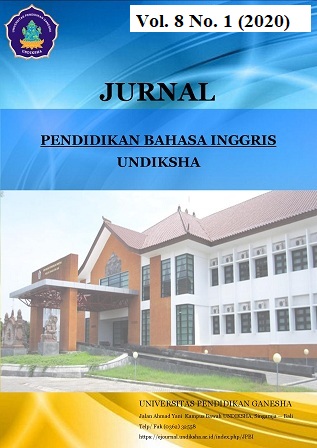THE ANALYSIS OF COMMUNICATION ACCOMMODATION STRATEGIES USED BY STUDENTS OF ENGLISH LANGUAGE EDUCATION OF GANESHA UNIVERISTY OF EDUCATION
DOI:
https://doi.org/10.23887/jpbi.v8i1.28637Abstract
Language development affects human speech. Speech is the way of communication. The purpose of communication involves how the information can be transferred to each other. People accommodate their communication in daily life to achieve the goal of communication. Another possible purpose which is expected by communicator is showing an identity. It can be done by using strategy based on Communication Accommodation Theory. Communication accommodation strategy is divided by two, divergence and convergence strategy. Phenomena of the use of convergence and divergence exist on students of English Language Education of Ganesha Univerisity of Education. English Language Education students are prepared as a teacher who needs prior knowledge about communication strategy that is expected for communication skill development. The population of the study is students of English Language Education of Ganesha University of Education who are from each regencies in Bali. This study used qualitative method with descriptive design which is expected can describe the use of Convergence and Divergence strategy within the reason of using each strategy. The variables being analyzed are speech rate, pauses, utterance length and lexical accommodation. The data is collected through observation and interview session. The result of study shows that students are possible to use multiple strategy in each variable based on current circumstance. The circumstance involves the place, interlocutor, intimacy, and speech community. All students uses convergence strategy in all variable and three of them use divergence strategy lexically. The reason of using each communication accommodation strategy is taken from communication accommodation theory.
Keywords: Communication Strategy, Communication Accommodation Theory
References
Afroz, A. and Koolagudi, S. G. "Recognition and Classification of Pauses in Stuttered Speech Using Acoustic Features," 2019 6th International Conference on Signal Processing and Integrated Networks (SPIN), Noida, India, 2019, pp. 921-926, doi: 10.1109/SPIN.2019.8711569.
Bilous, F. R., & Krauss, R. M. (1988). Dominance and accommodation in the conversational behaviours of same- and mixed-gender dyads. Language & Communication, 8(3-4), 183–194. https://doi.org/10.1016/0271-5309(88)90016-X
Brennan, S. E., & Clark, H. H. (1996). Conceptual pacts and lexical choice in conversation. Journal of Experimental Psychology: Learning, Memory, and Cognition, 22(6), 1482–1493. https://doi.org/10.1037/0278-7393.22.6.1482
Fais L., 1998. Lexical accommodation in human- and machine-interpreted dialogues. International Journal of Human-Computer Studies, 48(2), pp.217-246.
Coupland, N., 1980. Style-shifting in a Cardiff work-setting. Language in Society, 9(1), pp.1-12.
Douglas, H. Online Etymology Dictionary. Retrieved 2019-10-10.
Geere, M., Everett, J., & MacLeod, A. (2015). “My Vocal Cords are Made of Tweed”: Style-Shifting as Speaker Design. Lifespans and Styles, 1, 12-20. https://doi.org/10.2218/ls.v1i0.2015.1179
Giles, H. (2016). Communication Accommodation Theory: Negotiating Personal Relationships and Social Identities Across Context. Cambridge: Cambridge University Press
Giles, H., & Ogay, T. (2007). Communication Accommodation Theory. In B. B. Whaley & W. Samter (Eds.), Explaining communication: Contemporary theories and exemplars (p. 293–310). Lawrence Erlbaum Associates Publishers.
Giles, H., & Johnson, P. (1987). Ethnolinguistic identity theory: a social psychological approach to language maintenance, International Journal of the Sociology of Language, 1987(68), 69-100. doi: https://doi.org/10.1515/ijsl.1987.68.69
Giles, H., Coupland, J., Coupland, N. (1991). "Accommodation Theory: Communication, Context, and Consequence".
Giles, H., Coupland, J., Coupland, N. (1991). Contexts of Accommodation. New York, NY: Cambridge University Press.
Giles, H., St. Clair, R. (1979). Language and Social Psycology:Language in Society. Oxford: Basil Blackwell
Giles, H., Taylor, D. and Bourhis, R., 1973. Towards a theory of interpersonal accommodation through language: some Canadian data. Language in Society, 2(2), pp.177-192.
Hoyo, M.O., Allen, D. (2006). The Use of Triangulation Methods in Qualitative Educational Research. Journal of College Science Teaching, 35 (4), 42-47
Levin, H. and Lin, T., 1988. An accommodating witness. Language & Communication, 8(3-4), pp.195-197.
Liddell, H., Scott, R., Jones, H., McKenzie, R., Thompson, A. and Glare, P., 1996. A Greek-English Lexicon. Oxford: Oxford Univ. Press.
Pimsleur, P., Hancock, C. and Furey, P. (1977). Speech rate and listening comprehension, on English as a Second Language, New York: Regents, pp. 27–34.
Reed, M. and Levis, J., 2005. The Handbook Of English Pronunciation. UK: John Willey and Sons Ltd.
Zhan, C., (2013). Speech Community and SLA. Journal of Language Teaching and Research, 4(6).
Downloads
Published
Issue
Section
License
Authors who publish with the Jurnal Pendidikan Bahasa Inggris Undiksha agree to the following terms:- Authors retain copyright and grant the journal the right of first publication with the work simultaneously licensed under a Creative Commons Attribution License (CC BY-SA 4.0) that allows others to share the work with an acknowledgment of the work's authorship and initial publication in this journal
- Authors are able to enter into separate, additional contractual arrangements for the non-exclusive distribution of the journal's published version of the work (e.g., post it to an institutional repository or publish it in a book), with an acknowledgment of its initial publication in this journal.
- Authors are permitted and encouraged to post their work online (e.g., in institutional repositories or on their website) prior to and during the submission process, as it can lead to productive exchanges, as well as earlier and greater citation of published work. (See The Effect of Open Access)













